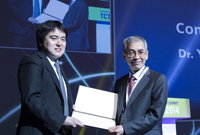| History of TCTAP Best Young Scientist Award |
 The 2nd Winner: Dr. Yusuke Watanabe The 2nd Winner: Dr. Yusuke Watanabe |
| Post-dilatation Reduces Paravalvular Aortic Regurgitation During TAVR Procedure with the Balloon-Expandable Edwards Valve |
| Yusuke Watanabe, MD (Institut Cardiovasculaire Paris Sud, France), who made a presentation about the usefulness of post-dilatation after implantation of the Edwards valve, won the TCTAP Best Young Scientist Award on Thursday in recognition of his accomplishments in the field of complex PCI and TAVR. |
| Remarkable Career in Interventional Cardiology |
| Dr. Watanabe is a Japanese cardiologist who graduated from Tsukuba University School of Medicine (Ibaraki, Japan). He practiced as an interventional cardiologist in Sakaibara Heart Institution doing remarkable researches in various subjects of cardiovascular intervention including aortic dissection, late stent malapposition after DES-implantation, and transcatheter aortic valve implantation. He was given credit for those activities when he was awarded for Best Scientific Research at TOPIC in 2012. He has been building up his career in France since 2011 and focusing on the TAVR procedure. |
| Interview with Dr. Yusuke Watanabe |
Q1) How do you feel about the award?
I am very honored to receive this award and grateful to the TCTAP committee for giving me this award. I greatly appreciate the support of the ICPS catheter team (Massy, France) and especially to my mentors of TAVI, Dr. Thierry Lefevre and Dr. Kentaro Hayashida.
Q2) What is your favorite valve in TAVR procedure?
I prefer to use Edwards Sapien XT valve because implantation procedure of Sapien is somewhat like coronary stenting procedure we interventional cardiologists are getting used to. However, limitation of Sapien valve definitely exists. I want to learn about CoreValve and other self-expanding valve implantation procedures next.
Q3) What is the best indicator in device size selection to avoid paravalvular regurgitation?
MDCT measurement of annulus sizing is crucial to avoid paravalvular regurgitation after TAVI. I think application of Valve/ CAAD (calculated average annulus diameter) ratio is very useful for optimal device sizing. Value of Valve/CAAD ratio 1.05-1.10 is optimal range for valve sizing. If there is a lot of calcification in the aortic root and LVOT, underfilling method is very useful.
Q4) What should we be cautious about when getting an optimal valve expansion without risk of annulus rupture?
We should carefully get accurate annulus size from MDCT image. Evaluation of the distribution and the amount of calcification is necessary to avoid adverse event like annulus rupture. The application of underfilling method will be useful in that case. If there is a certain risk of annulus rupture, choosing a self-expanding valve is good option.
Q5) How do you manage the remaining paravalvular regurgitation even after post-dilatation?
In that case, paravalvular regurgitation is due to calcification or position of valve, or the valve sizing is too small. The 2nd valve implantation sometimes provides good results in that case.
|









 The 2nd Winner: Dr. Yusuke Watanabe
The 2nd Winner: Dr. Yusuke Watanabe